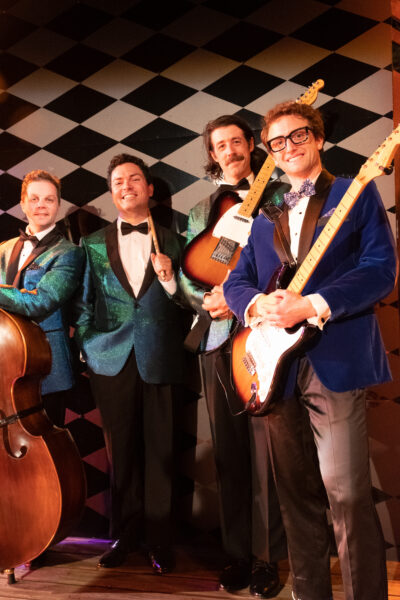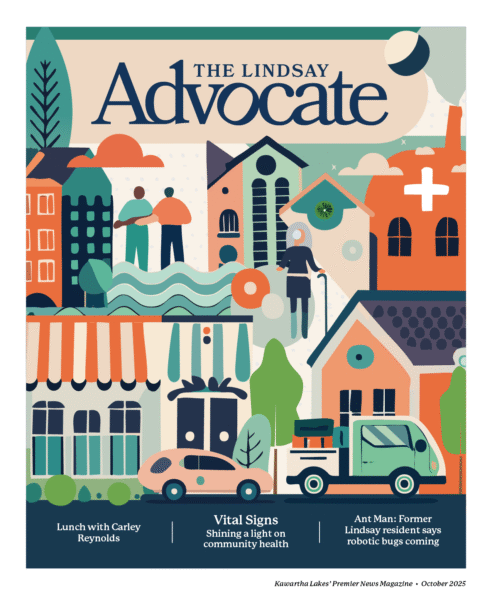Anatomy of a play
Behind the scenes with an actor, a director, and a stage manager at The Grove Theatre

When the curtain rises on opening night, the audience is unaware of the hours of rehearsal that have been going on for weeks. And they might not fully grasp the amount of work going on behind the scenes during the show.
Al Braatz is spending his summer at The Grove Theatre to star as Buddy Holly in Buddy: The Buddy Holly Story.
For him, an important step in his morning is doing warmups. Not only does he do vocal warmups, but he also does hand, finger, and full-body exercises to be fully prepared for the day ahead. “It’s a full-body sport,” he said.
As rehearsals begin, Braatz starts each day getting an idea of what the cast and crew will be doing on that day, the scenes and songs they’ll be rehearsing, and then “we just jump right into music rehearsals and start jamming and trying to really make sure that everything is (really) tight.”
From there the band spends a few hours rehearsing, making sure they’re all in tune with each other and getting the sound just right. About halfway through the day, they break for lunch. “We have an hour to kind of decompress,” Braatz said.
To him, it’s more than just about being able to recite lines, it’s thinking about the intent behind every word and movement. “You have to understand the setting, and you have to understand your social status within all of that. And once you kind of know those things, then you can start really building your character.”
With that, the stakes become even higher when dealing with a real person. “Especially with Buddy Holly, he’s such an iconic role model, and…he was a pioneer in the music industry. He changed music for so many people,” Braatz explained, wanting to ensure he does the character justice.
To find someone who cares so much about a character like Braatz, you need a director who is adamant about finding the right person.
Sean Cox is not only the director of Buddy Holly, he’s also the artistic director and co-founder of The Grove. His job as director involves the important task of hiring the right people to be the actors, designers, and people to be in charge of sets, lights, and sounds. Without a good crew, it’s hard to bring a show to life.
“I believe that it is my job to honour the playwright, to honour the material, and to make it accessible to the audience,” Cox said. The way he does this is by guiding and encouraging the performers to tell the story clearly to the audience in an enjoyable way.
“When we go into rehearsals, I have a very clear idea of the show, of how it works, and the staging, where the choreography is, the transitions and the lights and all that,” he said. Cox is able to be this prepared as he makes a model of the stage and uses action figures to represent the different roles on stage to help come up with clear staging and entrance and exits, ensuring there is always a good balance on stage.
During this time, he also likes to hear ideas from other people involved in the production, and he never says no to someone without at least trying an idea out first. “If somebody’s got an idea to do something different, I am very adaptable… As the director, it is my job to encourage the actors to make it their own.”
As Cox and Braatz are busy in rehearsals getting lines and cues performance-ready, stage manager Tracy Lynne Cann has a long list of responsibilities that are crucial to ensuring a show runs smoothly. From setting up rehearsal schedules, checking in with the director, and talking to production about all aspects of the show, including lights and prop placements.
“They call us the glue that holds everything together. We sort of have our hand in liaisoning with every department,” she said. Her job starts about a week before the performers do “getting the band’s scores printed and getting and making sure that the band has everything they need.”

Throughout rehearsal she’s helping make notes with Cox and, in a show like Buddy Holly, is also fact-checking, taking charge of things like ensuring that the glasses Braatz wears on stage are correct to what Buddy Holly had, and that performers are singing the lyrics correctly. “If you’re off on the script by a word or two, it probably doesn’t matter, but if you’re off on your lyrics, somebody is going to call you out on it.”
While everyone goes home at the end of a long day, it doesn’t mean that the work is over. Braatz spends time going through his notes from every day, so that the next day he can come in and showcase his performance with improvements. He’s also taken the opportunity to study archived footage of Holly to get his movements down pat. Essentially, he must do homework every night.
Once the rehearsal stage has finished, the show is put through a tech period “where it basically becomes the stage manager’s show,” Cann said. Unlike in film production, once the show is ready to open the director is already moving on to the next show, leaving the stage manager in charge.
Contrary to most stage directors, Cox is fortunate enough to not have to bow out completely when a show opens. Instead, he switches to focus on the art direction side of things, which also allows him to enjoy the show. “I’m a theatregoer, and at the end of the day, I want to direct a show that I want to see…a show that I’m proud to show off.”
As opening night approaches the energy in the theatre shifts. Nerves are high, and all the hard work put in over the previous weeks is about to culminate with the audience seeing the performance for the first time.
On opening night, Braatz makes a point to stay close to the rest of the cast, ready to offer support if anyone needs to talk. He also takes time to ground himself, saying, “I make sure I’m in my body and everything. I’ll sit in a chair for a good 15 minutes and just breathe and sigh, just kind of let out vocalizations and things like that.”
Once curtains are up, there are even more things Cann has to do to ensure a performance runs without difficulties. Stage managers oversee calling lighting and sound cues, they’re also on a headset with assistant stage managers (ASMs) to let them know when curtains are coming and when an actor should be entering. “It’s kind of like air traffic control,” she said.
More people are helping out behind the scenes than many realize. Alongside Cann are her ASMs, production assistants, wardrobe, a dedicated tech person backstage, a company manager, and a technical director.
While she’s busy helping run the show, she also must help her own crew make sure they have a routine backstage perfected, so everyone knows what they’re doing and aren’t running into each other. “It’s actually just as big as the performance on stage, and probably just as choreographed,” she said.
For her, seeing the show open to an audience is a cathartic moment, having spent so much work leading up to opening and just being able to sit back and enjoy it. “If we do a great job, nobody will know that we exist.”
By the time bows have been done, all thoughts turn to reflecting on the experience everyone just shared.
Theatre is a uniquely rewarding medium for Cox, as no two performances are ever the same. Each show evolves, shaped by the audience, the weather, and the energy on stage. “You watch your favourite movie today, it’s one thing. You watch it 20 years from now, it hasn’t changed. It’s the same, but a play or musical, it’s always different,” Cox explained. He finds great joy in witnessing that ever-changing magic, knowing that a show he helped bring to life transforms in its own way every single night.





